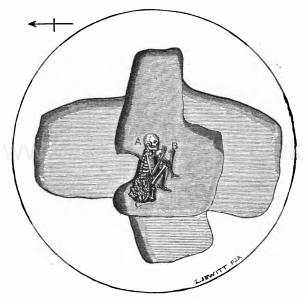The Reliquary Volume 8 1867-1868
The Reliquary Volume 8 1867-1868 is in The Reliquary.
Books, Prehistory, The Reliquary Volume 8 1867-1868 Five Wells and Gospel Hillock Barrows
Archæological Notes Made By Captain Francis Dubois Lukis H.M's 64th Regiment During A Visit To Buxton Derbyshire In 1865 By Frederick C Lukis (age 78) FSA.
In the Vestiges of the Antiquities of Derbyshire, published in 1848, by the late Thomas Bateman, Esq., at page 21, there is a short notice that near the little village of Chelmorton two considerable Barrows [Chelmorton Low Round Barrow 1 [Map] and Chelmorton Low Round Barrow 2 [Map]], within a short distance of each other, are to be seen, and Mr. Bateman further informs us that a Barrow was opened, according to Pilkington, by some labouring men who were searching for stones to build a walled fence in the neighbouring field; but from want of a further description and the necessary ground plan, I do not know if the following accidental visit to Chelmorton, and the examination of that neighbourhood by my son, Captain F. Dubois Lukis, in 1865, may not prove to be the identical locality mentioned in the Vestiges. Mr. Bateman likewise in the same publication gives a very short account of that place, as well as of some remains at the Five Wells, which seem to correspond with the facts mentioned by Pilkington, as also with the notes of Capt. Lukis.
Having been left with my son's letters and notes of his visit to Buxton, I deem it proper to record the few facts which fell under his notice during his short visit to that neighbourhood, in company with an invalid brother officer, Mr. Anderson, of his Regiment.
I would, however, apologise for so small a contribution to your excellent work, the "Reliquary," and the few additions to the vestiges of your county; but I deem it right that that work which you have assiduously carried on for so many years, should prove in reality a depositary of precious relics of the county of Derby.
I read with much interest the notices given in Vol. III. of the "Reliquary," and the explorings of some grave mounds by yourself and Mr. John F. Lucas, which, with some excellently executed plans and woodcuts, leave nothing to be desired in your illustrations.
May 1865. Captain Lukis writes as follows: - Buxton, May, 1865. Whilst roaming with Mr. Anderson in this neighbourhood, I soon perceived in various places unmistakeable signs of ancient occupation and remains, particularly in the vicinity of Chelmorton; on enquiry, I learnt that two largish cairns had been examined by the late Mr. Thomas Bateman. On strolling near the spot I found several portions of human bones in the debris and the soil, and on looking beyond from the height on which I stood I could discover other objects which I deemed worthy the notice of the antiquary. In thus pursuing my way across the country, I suddenly perceived, in the corner of a field, some stones having an artificial arrangement, and as I approached I found to my great delight a beautifully formed little cist [Five Wells Chambered Tomb [Map]]. I now send you a sketch of it from recollection, for I was not at the time provided with materials for a more accurate detail. I soon found that it had been opened, and the interior of it was filled with stones and weeds; the side props are of good dimensions and apparently not disturbed. I then quitted this pretty piece of ancient remains very reluctantly, and I felt my old taste for the 'Primevals' reviving in full force.
May 1865. On Tuesday, we however returned to it, and spent a long day at the Five Wells [Map], and being now furnished with the proper materials for exploring this interesting spot, we soon perceived that it contained a series of cists. I now send you a ground plan, and request to refer you to my first letter, wherein I gave you an account of our abrupt and accidental discovery of this spot.
We first opened ground in the direction from A to B, and dug some two to three feet below the surface. We then came to a regular pavement of flat stones, on these we found the remains of two or three individuals very much decayed - two human jaws in tolerable preservation lying on the floor - a few bones and the teeth of a dog or badger. The teeth of oxen and those of the horse were dispersed among the debris, but no pottery or anything else worth noticing. At D on the plan, I wish you to remark a transverse prop placed as a termination or divisional boundary to the pavement, which came home to it-this we have often remarked in the sepulchral tombs of Brittany and the Channel Islands. Between the side props of this trough from A to B, there appeared a dry walling connecting them in one line, as observable in other places. E E E were stones capable of serving for covering stones to this trough, and we conceived that they had been removed from their original position at some period when the cairn was disturbed or examined. F is the cist first seen, and the side prop G, on the south side, is a fine slab 7 ft. 8 in., by about 7 in. breadth and 18 in. in thickness.
This cist must have formed a very perfect little tomb, and probably distinct from the occupants of the trough on the west of it, as to date and quality of the being deposited therein; but these varied modes of sepulture might rather denote a different period of interment in the same mound, which has been proved in many localities in England and other countries.
We then left this spot to its lonely genius, but the kind farmer who lives in the place and farms the land informed me that he had resided there upwards of 24 years, and had never known any examination of the spot during that period1;he, however, added that an old man, who had worked upon the land before he came to reside there, had told him that once in digging for stones in the same mound, he had discovered several pots and skeletons, with plenty of human teeth.
The present upright stones, which first attracted my notice are from four to five feet above ground, they are important enough from a distance to an experienced eye, but being near the corner of the field with a high stone wall near them they would be rather concealed from view.
I then visited the cottage of George Walker, who resides near, and who, on inquiry, informed me that he had found many flint arrow heads, which he described very accurately, as well as two or three celts, mentioning the place where they were found. He further added that had he time he could discover plenty more! As I knew the places indicated by this man I make little doubt of the truth of his statement. Had the weather been more favourable I should have been disposed to attempt the search for these, for in this county flints are the exception, amidst the fragments of limestone and toadstone.
The longest celt discovered by Walker is now in the possession of Mr. Bateman. This man gave me a very fair flake of flint, which greatly confirmed his account of these materials.
This interesting episode in my present journey to Buxton has proved one of great delight and a relaxation from the duties of a camp life, and our recent Indian campaign. I indeed felt truly happy in again following that pursuit which you have taught us almost from our cradle to take delight in, and when we received orders from head quarters to join our regiment at Manchester and to bark for Ireland, we felt well nigh broken-hearted. My companion, who now begins to be almost as much interested in these pursuits as myself, only consoles himself with the hope that some future opportunity may occur to bring him again in this interesting neighbourhood.
Llewellynn Jewitt.
Note 1. In this "the kind farmer" was certainly wrong. In 1846 the place was examined by my late friend Mr. Bateman, who, in his "Vestiges of the Antiquities of Derbyshire," page 91, thus records the fact: - "On the summit of Five Wells Hill, near Taddington, is one of the most perfect examples now existing of the sepulchral architecture of the aboriginal inhabitants of Britain: it consists of two vaults situated in the centre of a cairn, about thirty yards in diameter, each approached by a separate gallery or avenue, formed by large limestones standing edgeways, extending through the tumulus, respectively in a south-east and north-west direction. This structure appears to have been first discovered at the time of the inclosure of the moors, when a great part of the barrows were used inmaking the surrounding fences; at this time many hones were found in the vaults. On the 25th of August, 1846, the two galleries were cleared out in order to ascertain if any articles had been overlooked by the parties who first opened the barrow; but, with the exception of a flint arrow point, and numerous bones, some calcined, nothing of primitive date was discovered. The quantity of bones of both sexes, and of various ages, indicate this tumulus to have been used as a burying-place for a considerable time; on this occasion the lower jaws of twelve different persons were collected.
In 1851, Mr. Bateman, in a communication to the British Archæological Association, alluded to this tumulus, and sent up a drawing and ground plan, which are engraved in the Journal of the Association, Plate XVIII. Vol VII.
In 1862, I myself made a partial examination of the place, the result being simply the discovery of one or two fragments of pottery, and a flint. I give on Plate II. (fig. 3) a ground plan, with measurements, which I made of the principal chamber.
The place had previously, in 1810, been visited by my father, the late Mr. Arthur Jewitt, and described by him in his "History of Buxton". He therein says that when the cists were first discovered, a workman, I presume in getting stone, "by chance laid bare an open entrance to the east, composed of two large upright stones, with an impostover them," and, venturing in, found a skeleton or two in perfect preservation. Retreating he told his fellow-workmen what he had seen, "and numbers came to look at the place, and soon spread a report of its containing many bodies, and, as a certain consequence, of its being haunted. This however in time died away, and neither bodies nor goblins have been able to preserve it from almost total destruction." At that time (1810) myfather made a rough sketch and ground plan of the place, and of these I give reduced copies on Plate II. ( figs. 1 and 2 ), and also, on the same plate ( fig. 4), I give the ground plan as taken by Mr. Bateman when he examined the cists in 1846. A further and more detailed account of this interesting chambered tumulus, and of others of the same general character, will be given in a future number.
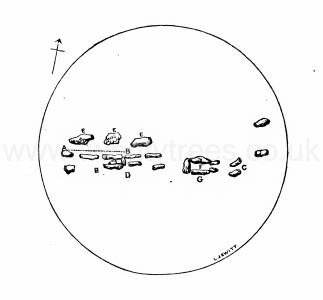
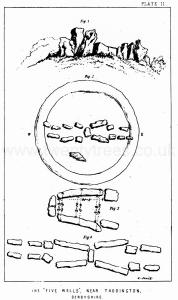

When we were about quitting Buxton, I was beginning to make a host of friends amongst the farmers and labourers, and from them obtained lots of information; this led me in my rambles over the spot where I was informed that two stone knives had been picked up (one of which was sent to London, and the other given to Mr. Bateman). I was climbing hill after hill without any positive certainty of meeting with anything of interest, when suddenly I saw, whilst crossing a wheat field, unmistakable signs of a Barrow [Map] [Gospel Hillock Barrow [Map]]. I called on the farmer, Mr. Charles Holmes, and on pointing to the heap of stones he at once exclaimed, 'Oh, sir, I wish they were out of that, for when ploughing that field we are sadly plagued by them.' I then asked to be allowed to make a small hole with a spade in the mound; this, he said, he could not grant, but added that if I were to call on the Rev. Mr. Pickford, the owner of the property, he doubtless would grant me permission to do so. After a walk to the house, and explaining the object of my visit, Mr. Pickford very kindly gave me leave on condition of levelling the ground again.
The next day we repaired to the place, and shortly after we were met by Miss Pickford, his sister, who most obligingly gave us the history of the mound in question. She narrated as follows 'The place was called from time immemorial "The Gospel Hillock;" the mound was held in considerable estimation and reverence, as its name imports, for here, in perilous times, people repaired for religious purposes, and holy persons preached and read the scriptures, whence it had obtained the name by which it was known.' We of course assented with her on its sacred character, and we thanked her for the valuable information we had obtained, and after her departure we commenced our operations with spade and pick, not doubting that ere long by these means the exact nature of 'Gospel Hillock' would tell a different tale as to its origin and purpose.
We commenced digging over that part marked a on the plan, and after proceeding with the usual caution always necessary in working on a low barrow, our spade soon produced the signs of interment - a few human bones were perceptible, which doubtless belonged to some skeleton not far distant. In a short time at the depth of a foot a skeleton was discovered, lying partly on its back with its legs evidently doubled up. We were the more surprised at finding this subject lying upon a flat surface or level of a stone, apparently of large dimensions. The very solid floor on which this individual lay induced us to extend out search, in order to determine its extent; in doing this we discovered several conical studs of polished kimmeridge coal, drilled with two connecting holes for being strung or fastened in the usual method of that period. The skull was evidently towards the east, and the cervical vertebræ, ribs, and bones of the arms, mixed up with the legs and the fingerbones, indicating that the body had not been stretched out, but rather in a doubled up position.
In proceeding to remove the earth in a westerly direction, I suddenly touched the skull of another individual lying in nearly the same position, and ex tended towards the western part of the large stone. Whilst cautiously clearing the earth away from the head, I fortunately perceived the keen edge of a flint celt, at E, (shown on the accompanying engraving), which lay on the stone and near the south side of the shoulder of B. I could scarcely express to my companions the delight I then felt, and as neither of them were acquainted with the nature of a celt, they were the more astonished at the cause of my excitement. Before removing the instrument I endeavoured to explain to them what their uses were, among all nations ancient and modern, and tried to answer a hundred questions which the subject gave rise to. After a very learned lecture on the celt, I gently extracted the object of my joy.
This little incident caused some delay in our operations, and after having exposed the second skeleton, we cleared the edge of the stone at c, and there found a third individual lying in the trench near it, and partly touching the large stone, which we now found measured 7 ft. 8 in. in diameter by 7 ft. 3 in. wide. Fragments of bones, teeth, and a few flint chippings were found also.
Note A. D, the pick-axe struck upon a largish stone, and in pursuing our work in that direction, we came upon a perfect little chamber without any covering stone, and on working down to the same level as our trough we came upon a pavement of flattish stones, on which were laid two skeletons; the western limit being closed up by stones and dry walling. Flint flakes were more numerous here, and against the northern props there was a neat urn, or drinking vessel, of reddish clay (but in the interior of a dark colour). On the external surface were eight circular rows of vertical indents, somewhat rudely engraved. The height was about seven inches, and it was not inelegant in its out line. This urn is here engraved.
After completing the excavation round the central stone we left off our work, intending on the morrow, if possible, to raise the flat suspicious base on which the skeletons reposed, and ascertain if it might not prove a covering to some more interesting deposit. The weather, however, was too wet and stormy for our work on that day.
On the following morning we repaired to the spot with that intention, but on arriving there found that the whole had been recovered and filled, by order of Mr. Pickford - that gentleman having unfortunately concluded that we were not to return to "Gospel Hillock" and restore it to its former outline as we had promised to do.
In forwarding these few notes and observations, I beg to say that they were written by Captain Lukis for insertion in my own collectanea, but if you consider them worthy of a place in the "Reliquary," it will afford him some pleasure to know that his visit to Derbyshire was not in vain.
The Grange, Guernsey.
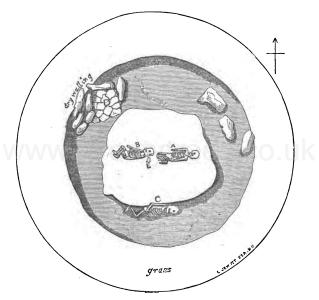
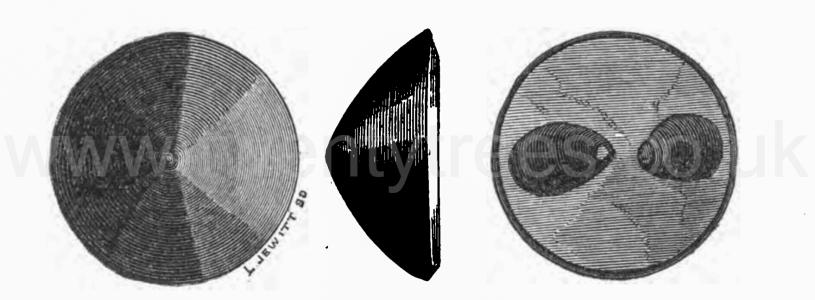
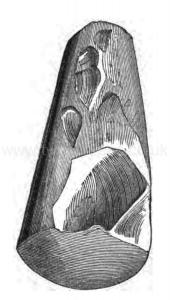
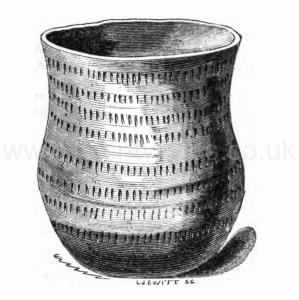
Books, Prehistory, The Reliquary Volume 8 1867-1868 High Field Hlaew
A record of all barrows that are opened should be kept, and any facts, however trifling they may appear at the time, carefully noted, I send the following account of a grave-mound opened by me upon the estate of His Grace the Duke of Devonshire, who kindly allowed me to examine it. The mound is situated on the summit of a hill called Grey Cap, overlooking Cressbrook Mills, and from which a most charming view of that valley is to be obtained. It is in diameter about fifteen yards at the present time, and is raised three feet above the natural surface of the land; it is composed of fine soil to the depth of eighteen inches from the surface, which, from the almost entire absence of even a single stone, I take to be for the most part an accumulation of decayed vegetable matter; the remaining eighteen inches to the natural surface being composed of small surface stones only. We commenced our examination of it by cutting a trench four feet wide from the eastern side in a direction towards the centre, finding amongst the stones, under the fine soil above-named, a quantity of rats' bones, a few small chippings of flint, a few fragments of burnt human bones and animal teeth, which encouraged us to proceed, and when we arrived at the centre upon carefully removing the stones we found the skeleton of a female, lying with the head to the east, in a contracted position on its left side, as shewn in the plan at the head of this paper, having a nicely chipped flint, half-an-inch in diameter, placed against the upper part of the skull; the bones, however, were much broken up by the falling in of the cist, which had only consisted of small stones, and much decayed by its being placed upon the soil and not upon a floor formed of stone as is usually the case. The entire left side of the skull is completely decayed, and only sufficient is left of the remaining part, and that in small fragments, to shew it to be that of a young female. On carefully uncovering the bones we came upon the remains of a child of tender age, which had been placed lying in the arms of the skeleton in the same position against the chest; these of course were in a very advanced state of decay, the principal bones only being distinguishable. Proceeding to uncover the remaining bones, we found they had been much displaced, the pelvis and parts of the vertebræ being entirely wanting; this we found was owing to an interment by cremation having been placed where the pelvis had been, and so a great part of the bones had not only been displaced, but thrown out to make room for them; they were merely placed on a heap and covered by small stones, two flakes of highly burnt flint being with them only. Wishing to make a thorough examination and plan of the barrow, we proceeded the next day to extend the former opening on all sides, as shewn, but found nothing beyond two very small pieces of pottery, and a small chipping of flint.
